#neutron stars
Text
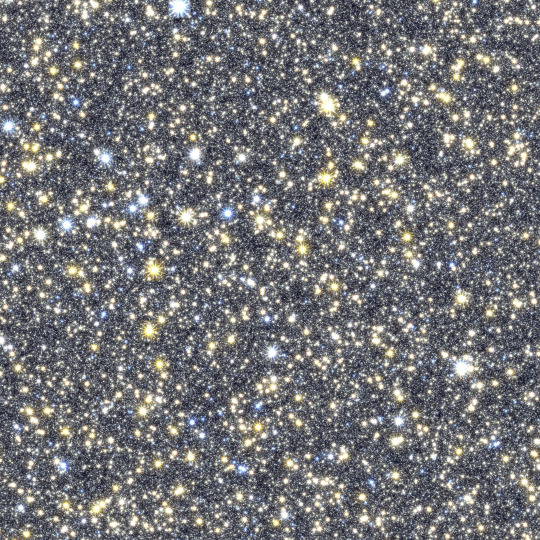
A simulated image of NASA’s Nancy Grace Roman Space Telescope’s future observations toward the center of our galaxy, spanning less than 1 percent of the total area of Roman’s Galactic Bulge Time-Domain Survey. The simulated stars were drawn from the Besançon Galactic Model.
Exploring the Changing Universe with the Roman Space Telescope
The view from your backyard might paint the universe as an unchanging realm, where only twinkling stars and nearby objects, like satellites and meteors, stray from the apparent constancy. But stargazing through NASA’s upcoming Nancy Grace Roman Space Telescope will offer a front row seat to a dazzling display of cosmic fireworks sparkling across the sky.
Roman will view extremely faint infrared light, which has longer wavelengths than our eyes can see. Two of the mission’s core observing programs will monitor specific patches of the sky. Stitching the results together like stop-motion animation will create movies that reveal changing objects and fleeting events that would otherwise be hidden from our view.
youtube
Watch this video to learn about time-domain astronomy and how time will be a key element in NASA’s Nancy Grace Roman Space Telescope’s galactic bulge survey. Credit: NASA’s Goddard Space Flight Center
This type of science, called time-domain astronomy, is difficult for telescopes that have smaller views of space. Roman’s large field of view will help us see huge swaths of the universe. Instead of always looking at specific things and events astronomers have already identified, Roman will be able to repeatedly observe large areas of the sky to catch phenomena scientists can't predict. Then astronomers can find things no one knew were there!
One of Roman’s main surveys, the Galactic Bulge Time-Domain Survey, will monitor hundreds of millions of stars toward the center of our Milky Way galaxy. Astronomers will see many of the stars appear to flash or flicker over time.
youtube
This animation illustrates the concept of gravitational microlensing. When one star in the sky appears to pass nearly in front of another, the light rays of the background source star are bent due to the warped space-time around the foreground star. The closer star is then a virtual magnifying glass, amplifying the brightness of the background source star, so we refer to the foreground star as the lens star. If the lens star harbors a planetary system, then those planets can also act as lenses, each one producing a short change in the brightness of the source. Thus, we discover the presence of each exoplanet, and measure its mass and how far it is from its star. Credit: NASA's Goddard Space Flight Center Conceptual Image Lab
That can happen when something like a star or planet moves in front of a background star from our point of view. Because anything with mass warps the fabric of space-time, light from the distant star bends around the nearer object as it passes by. That makes the nearer object act as a natural magnifying glass, creating a temporary spike in the brightness of the background star’s light. That signal lets astronomers know there’s an intervening object, even if they can’t see it directly.
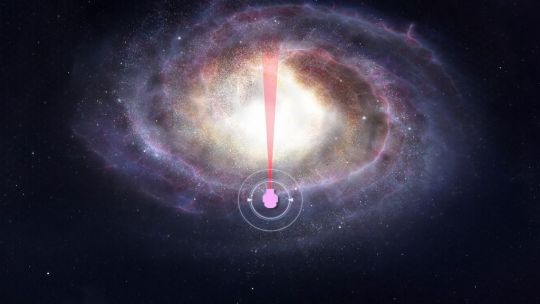
This artist’s concept shows the region of the Milky Way NASA’s Nancy Grace Roman Space Telescope’s Galactic Bulge Time-Domain Survey will cover – relatively uncharted territory when it comes to planet-finding. That’s important because the way planets form and evolve may be different depending on where in the galaxy they’re located. Our solar system is situated near the outskirts of the Milky Way, about halfway out on one of the galaxy’s spiral arms. A recent Kepler Space Telescope study showed that stars on the fringes of the Milky Way possess fewer of the most common planet types that have been detected so far. Roman will search in the opposite direction, toward the center of the galaxy, and could find differences in that galactic neighborhood, too.
Using this method, called microlensing, Roman will likely set a new record for the farthest-known exoplanet. That would offer a glimpse of a different galactic neighborhood that could be home to worlds quite unlike the more than 5,500 that are currently known. Roman’s microlensing observations will also find starless planets, black holes, neutron stars, and more!
youtube
This animation shows a planet crossing in front of, or transiting, its host star and the corresponding light curve astronomers would see. Using this technique, scientists anticipate NASA’s Nancy Grace Roman Space Telescope could find 100,000 new worlds. Credit: NASA’s Goddard Space Flight Center/Chris Smith (USRA/GESTAR)
Stars Roman sees may also appear to flicker when a planet crosses in front of, or transits, its host star as it orbits. Roman could find 100,000 planets this way! Small icy objects that haunt the outskirts of our own solar system, known as Kuiper belt objects, may occasionally pass in front of faraway stars Roman sees, too. Astronomers will be able to see how much water the Kuiper belt objects have because the ice absorbs specific wavelengths of infrared light, providing a “fingerprint” of its presence. This will give us a window into our solar system’s early days.
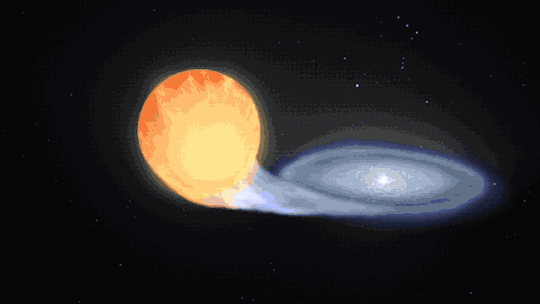
This animation visualizes a type Ia supernova.
Roman’s High Latitude Time-Domain Survey will look beyond our galaxy to hunt for type Ia supernovas. These exploding stars originate from some binary star systems that contain at least one white dwarf – the small, hot core remnant of a Sun-like star. In some cases, the dwarf may siphon material from its companion. This triggers a runaway reaction that ultimately detonates the thief once it reaches a specific point where it has gained so much mass that it becomes unstable.
youtube
NASA’s upcoming Nancy Grace Roman Space Telescope will see thousands of exploding stars called supernovae across vast stretches of time and space. Using these observations, astronomers aim to shine a light on several cosmic mysteries, providing a window onto the universe’s distant past. Credit: NASA’s Goddard Space Flight Center
Since these rare explosions each peak at a similar, known intrinsic brightness, astronomers can use them to determine how far away they are by simply measuring how bright they appear. Astronomers will use Roman to study the light of these supernovas to find out how quickly they appear to be moving away from us.
By comparing how fast they’re receding at different distances, scientists can trace cosmic expansion over time. This will help us understand whether and how dark energy – the unexplained pressure thought to speed up the universe’s expansion – has changed throughout the history of the universe.
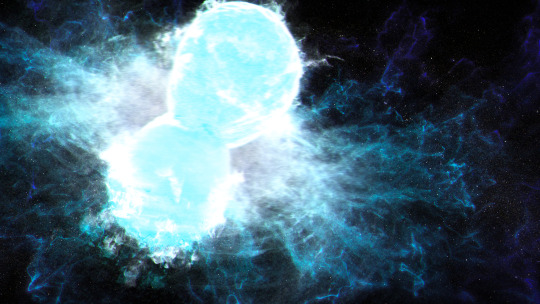
NASA’s Nancy Grace Roman Space Telescope will survey the same areas of the sky every few days. Researchers will mine this data to identify kilonovas – explosions that happen when two neutron stars or a neutron star and a black hole collide and merge. When these collisions happen, a fraction of the resulting debris is ejected as jets, which move near the speed of light. The remaining debris produces hot, glowing, neutron-rich clouds that forge heavy elements, like gold and platinum. Roman’s extensive data will help astronomers better identify how often these events occur, how much energy they give off, and how near or far they are.
And since this survey will repeatedly observe the same large vista of space, scientists will also see sporadic events like neutron stars colliding and stars being swept into black holes. Roman could even find new types of objects and events that astronomers have never seen before!
Learn more about the exciting science Roman will investigate on X and Facebook.
Make sure to follow us on Tumblr for your regular dose of space!
#NASA#astronomy#telescope#Roman Space Telescope#dark energy#galaxies#cosmology#astrophysics#stars#galaxy#space images#time#supernova#Nancy Grace Roman#black holes#neutron stars#kilonova#rogue planets#exoplanets#space#science#tech#technology#Youtube
2K notes
·
View notes
Text

Billions of stars and planets in this photo.
#stars#neutron stars#astronomy#nasa#astronomers#universe#astrophotography#nasa photos#astrophysics#outer space#nasawebb#hubble space telescope#planetary science#planetary nebula#alien planet#galaxia#galaxy#galaxies#astrography#i love astronomy#astronomy facts#astrobiology#astro community#astro notes#astro observations#astroblr#space exploration#space#cosmos#our universe
395 notes
·
View notes
Text

It can be expensive to hire a professional spectroscopist for your wedding, but the quality of the spectra you get is worth it.
Gold [Explained]
Transcript Under the Cut
[Cueball holding some small sparkling thing, implied to be a gold wedding ring]
Cueball: It kinda makes sense that we use gold for wedding rings.
[Frame shifts to Cueball's head]
Cueball: Because a lot of the universe's gold was probably produced by R-process nucleosynthesis when pairs of neutron stars spiraled together and merged.
Cueball: So gold exists because two neutron stars got married.
[Megan walks in from side towards Cueball]
Megan: "Binary neutron star merger" would be a fun wedding theme.
Cueball: Everyone has to try not to catch the relativistically-ejected bouquet.
422 notes
·
View notes
Text
hello! i've got some GROUNDBREAKING space news for you!
scientists have uncovered evidence for a gravitational wave background (GWB) in our universe, and the way they went about it is fascinating.
To fully understand what's going on here, we need to go into a bit of background information.
First of all: what are gravitational waves? gravitational waves are often called 'ripples' in spacetime, often caused by extremely energetic processes such as black holes colliding, or two neutron stars orbiting each other closely.
So, how did scientists figure this out? They used 67 pulsars (known as the Pulsar Timing Array) throughout the Milky Way, practically creating a galaxy-sized telescope in order to study this.
Pulsars are the extremely dense cores of massive stars, left over after they go supernova. These are fascinating on their own, but for this project, they had an essential feature: Pulsars rapidly rotate (think up to hundreds of rotations per second), spewing radiation out in pulses from their magnetic poles. For some pulsars, these radiation jets cross Earth's line of sight, and we get incredibly constant bursts of radio signals, which can be catalogued and used as a sort of standard, universal clock.
Here is a link to a gif showing the rotation of a pulsar. Please be warned for flashing and eyestrain.
For 15 years, a team of astronomers working for the North American Nanohertz Observatory for Gravitational Waves (NANOGrav), used radio telescopes around the globe to track minuscule changes in the signal patterns from pulsars. The changes they found are due to the slight movement of spacetime between us and the pulsars, stretching and compressing the paths of their radio waves as extremely low frequency gravitational waves pass through the universe (yes, that includes you. your atoms, as well as the atoms making up everything around you, are very slowly shifting position, dancing along to the heartbeat of the universe).
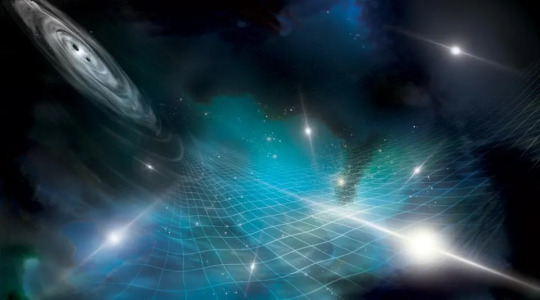
At the moment, scientists are still debating what could have caused this gravitational wave background, but some there are some leading theories: the GWB could be caused by trillions of binary black hole systems (black holes orbiting each other) throughout the universe. It could also be due to cosmic inflation, or even the big bang itself. Scientists just don't know yet, but the opportunities this discovery opens up are incredible.
The knowledge of the GWB could help us better understand the formation of early galaxies, or even help us understand the origin of the universe.
#aspaceinthecosmos#space#astronomy#outer space#just jupiter#astrophysics#gravity#gravitational waves#physics#pulsars#black holes#neutron stars#the universe#LIGO
595 notes
·
View notes
Text
Scientists have discovered the first indication of nuclear fission occurring amongst the stars. The discovery supports the idea that when neutron stars smash together, they create "superheavy" elements — heavier than the heaviest elements of the periodic table — which then break down via nuclear fission to birth elements like the gold in your jewelry.
Nuclear fission is basically the opposite of nuclear fusion. While nuclear fusion refers to the smashing of lighter elements to create heavier elements, nuclear fission is a process that sees energy released when heavy elements split apart to create lighter elements. Nuclear fission is pretty well known, too. It's actually the basis of energy-generating nuclear power plants here on Earth — however, it had not been seen occurring amongst the stars before now.
"People have thought fission was happening in the cosmos, but to date, no one has been able to prove it," Matthew Mumpower, research co-author and a scientist at Los Alamos National Laboratory, said in a statement.
Continue Reading.
212 notes
·
View notes
Text
the beauty of the cosmos is so magical 💜🖤💫✨🪐☄️🌌🌠



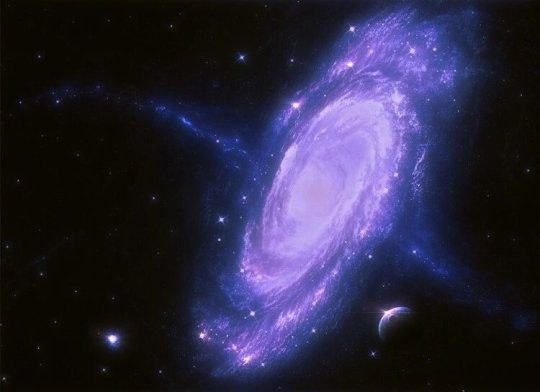
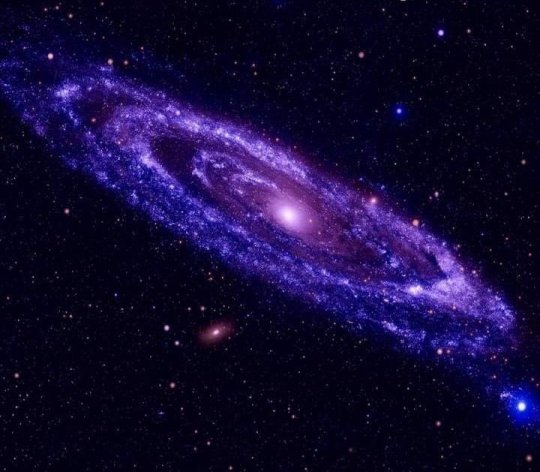


#space#cosmos#night sky#universe#cosmic#celestial#astral#stars#nebula#galaxy#supernova#nova#comet#asteroid#neutron stars#pulsar#quasar#black hole#planets#dark matter#astronomy#cosmology#planetary science#astrophysics
134 notes
·
View notes
Text
Ive been drawing a lot for myself lately : ]

#neutron stars#supernova#this part of my notes for space.i had a 4 and a half hour long Moment about it yesterday#i want to return to digital art soon#i have a lot of written prompts for character interactions but for some reason my brain interprets it as a CHORE#mitzdraws
85 notes
·
View notes
Text
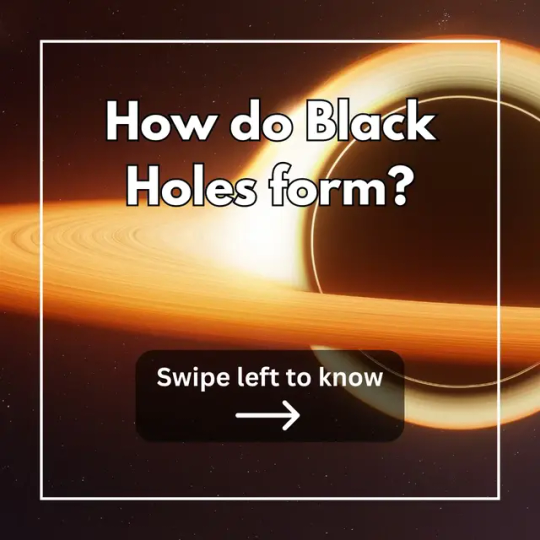

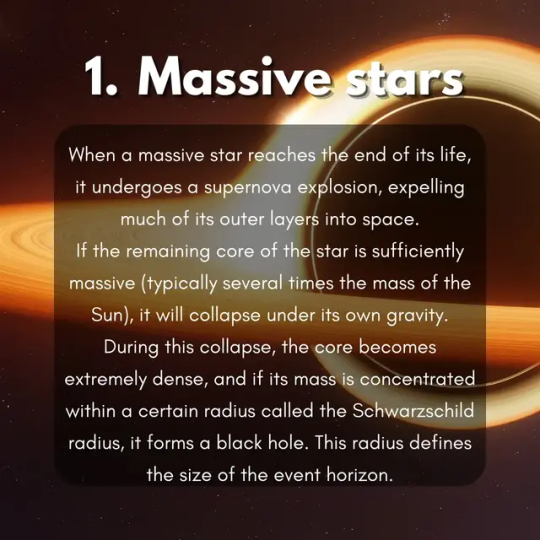


Feeling stressed? Imagine being squeezed into a point smaller than an atom! 😱 That's what happens at the heart of a black hole. Swipe ➡️ through this post to learn how these cosmic wonders are formed! 🌌✨
#black hole#stephen hawking#neutron stars#cosmic chatter#singularity#event horizon#astronomers#astro#stars#stellar#astronomy#astrophotography#astrophysics#cosmology#cosmos#space#nasa#galaxy#universe#science#science facts#education#discover#study blog#studyblr#scicomm#explore#physics#cool science#simps for science
36 notes
·
View notes
Text
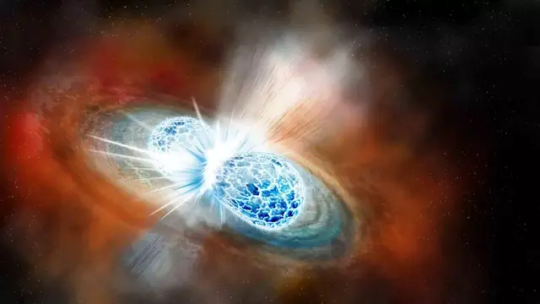
James Webb Space Telescope spots violent collision between neutron stars
#james webb telescope#James Webb Space Telescope#james webb#astronomy#space#sky#universe#stars#neutron stars#god's creation#godscreation#nature#god's creatures#gods creatures#beauty#love
129 notes
·
View notes
Text
A magnetar is a type of neutron star with an extremely powerful magnetic field (∼109 to 1011 T, ∼1013 to 1015 G). The magnetic-field decay powers the emission of high-energy electromagnetic radiation, particularly X-rays and gamma rays ⚡️

#nasa#astronomy#astrophotography#astrophysics#physics#james webb space technology#james webb images#stars#magnetar#solar system#neutron stars#space advances#science acumen#nebula#powerful#space
85 notes
·
View notes
Text
76 notes
·
View notes
Text

COMET 144P KUSHIDA
#astronomy#nasa#astronomers#universe#astrophotography#nasa photos#astrophysics#outer space#nasawebb#hubble space telescope#comets#comet#nebula and quasar#heart nebula#neutron stars#planetary nebula#planetary science#science facts#space science#science#space program#space exploration#space#i love astronomy#astronomy facts#astrography#astro notes
153 notes
·
View notes
Text
Greetings, it's me, your favourite purple genius & I have a special dish aka infodump for you:
✨️ Pulsars ✨️
Like I promised to a friend.
I referred to pulsars as 'dead stars', which is not incorrect:
Pulsars are rapidly rotating neutron stars that blast out pulses of radiation at regular intervals ranging from seconds to milliseconds.
The name 'pulsar' can be misleading as these neutron stars don't actually pulse by periodically shrinking & swelling in size. Their pulsing is merely a factor of their orientation in relation to our view of them.
Their light output is mostly consistent.
Pulsars have strong magnetic fields that funnel particles along their magnetic poles, accelerating them to relativistic speeds, which produces two powerful beams of light, one from each pole.
The poles of the magnetic field aren't aligned with the axis of spin of the pulsar: the beams of particles & the light they produce are swept around as the pulsar rotates.
Imagine this as a pair of open scissors spinning on one handle. One blade points upwards (axis of rotation), while the other blade is the beam of light. While the axis of rotation has the same orientation, the direction of the beam turns with the neutron star's spin.
The periodicity of pulsars is caused by these beams of light crossing the line of sight here on Earth, with the pulsar appearing to 'switch off' at points when the light is facing away from us. The time between these pulses is the 'period' of the pulsar.
✨️How do they form?✨️
Just like neutron stars, pulsars are born when stars with masses between four & eight times that of the sun run out of fuel for nuclear fusion.
When the fusion of lighter elements into heavier elements stops - iron is end of the fusion chain - the production of energy that supports the massive star against the inward pressure of its own tremendous gravity also ceases. The star begins to collapse.
The outer layers of the star are blown away in a supernova explosion with only the iron core of the massive star containing masses equivalent to that of the sun up to about 1.5 times that of our star remaining. This crushes down into a width no greater than around 19 to 27 kilometers.
This creates the neuron star: which is composed of 95% neutrons, because the collapse has forced electrons & protons together.
According to NASA, the material that comprises neutron stars is so dense that a mere teaspoon of it would weigh 4 billion tons. This is equivalent to 10,000 Empire State Buildings stacked on a tiny spoon!
This superdense material is prevented from cramming further together as the mass of the stellar core can't overcome the quantum properties of its neutrons.
If the star was massive enough to overwhelm this effect the neutron star would continue to collapse until it transforms into a black hole.
This is the 'Crab pulsar':

Image credit: NASA/CXC/ASU/J.Hester et al.
There you have it! 🌟
✨️What is so intriguing about them?
Pulsars tell about the physics of neutron stars: Under such incredible pressure, matter behaves in ways not seen before in any other environment in the universe. The strange state of matter inside neutron stars is what scientists call 'nuclear pasta': Sometimes, the atoms arrange themselves in flat sheets, like lasagna, or spirals like fusilli, or small nuggets like gnocchi.
They are considered the most reliable & accurate clocks of the universe & can be used for distance measurements!
As mentioned before: detecting gravitational waves!

(Me definitely NOT enjoying this) /s
#donatello infodumps#donnies exceptional mind#turtle net#rottmnt donnie#rottmnt autistic donnie#rise autistic donnie#autistic donatello#space#space is awesome#pulsars#rottmnt donatello#rottmnt#infodumping#infodump#space facts#neutron stars#astrophysics
45 notes
·
View notes
Text

#meme#memes#shitpost#shitposting#humor#dark humor#funny humor#funny memes#funny#lactose intolerance#lol#milky way#neutron stars#sarcasm#satire#irony#silliness
69 notes
·
View notes
Text
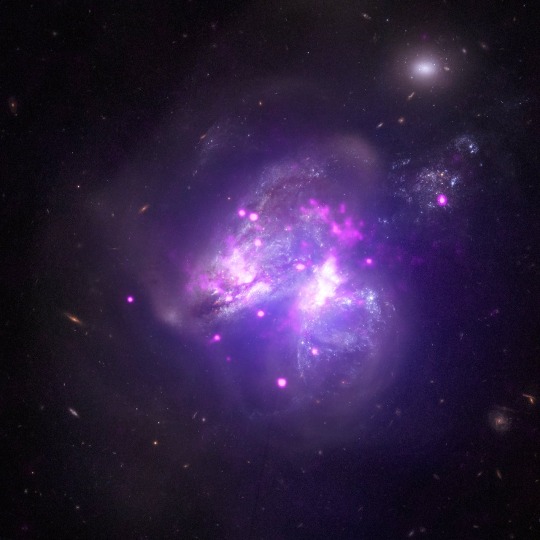
💫 “Today Chandra is studying a Black Hole in Ursa Major. Nearby in the sky two galaxies are merging in Arp 299. At least 14 "ultra-luminous X-ray sources" (ULXs) have been discovered here. All are likely black holes or neutron stars pulling material from a companion star.”
source . more from chandra x-ray observatory .
#space#chandra#chandra observatory#chandra x ray observatory#nasa#outer space#black hole#Ursa Major#constellations#neutron stars#stars#neutron star#galaxy#galaxies#space photography#astronomy
93 notes
·
View notes
